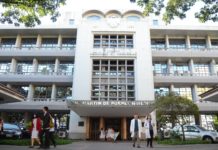THE FUTURE in alternative methods.
Potential plant remedies, analysis of management problems, new sources of energy and finding remedies to the country’s ailing aquaculture were the focus of this year’s best undergraduate scientific theses around the University.
Bleeding is a vascular disease said as one of the top ten causes of morbidity in the country and in addressing such problem, bleeding has to be controlled in a vital process involved in wound healing called hemostasis.
Pharmacy students Solmuell Florano, Patricia Sigua, Maria Tabi, Aleonor Trinidad and Ina Vergara sought to prove the hemostatic potential of the plant Musa errans, commonly known as saging botoan, in their research titled “In Vivo Determination of the Hemostatic Potential of the Decoction of the Peel of Musa errans (Blanco) Teod. var. botoan Teod. on Sprague-Dawley Rats.”
“The hemostatic activities of M. acuminate and M. paradisiaca have already been established by studies conducted abroad,” Sigua said. “We chose M. errans as a target of our research because it [is endemic] and economically practical.”
Results showed that rats, the tips of whose tails were cut safely for the study, administered with the decoction from the peel M. errans healed faster compared to a control group that was administered with distilled water, suggesting that an alternative method in curing bleeding disorders could be developed out of banana peels.
Plant extracts show promising potentials to fight diseases, like another plant capable to kill cancer cells in the liver and proves to be a cost-efficient method.
Biochemistry graduates Kelsey Dayrit, Pamela Correa, Angela Aguila and Mary de Leon sought to find out the potential of Ficus odorata, commonly known as pakiling, to fight liver cancer in their thesis titled, “Cytotoxic and Genotoxic Effect of the Crude Ethanolic Leaf Extract of Ficus odorata (Blanco) Merr. (pakiling) in Human Hepatocellular Carcinoma (HepG2).”
Cytoxicity refers to the toxicity of a chemical substance to cell while genotoxicity is the capacity of a substance to cause mutations which can lead to cell death. Chemical compounds having these properties can potentially kill cancer cells.
Extracts isolated from the leaves of F. odorata showed the plant’s potential to protect the liver and prevent the development cancer.
Relationship in health
In their thesis titled “Examining the structural relationship of chronic illness, physical function, life satisfaction and social support in the development of depression among Filipino elderly in institutionalized care settings,” Nursing students Josette Jurado and Josephine Juson sought to check if there is a relationship between different experiences by Filipino elderly in the development of depression.
Using Structural Equation Modeling, the team correlated variables such as chronic illness, physical function, life satisfaction and social support to depression.
Results showed that a present chronic illness had a negative effect on the physical functioning and life satisfaction of the elderly. It was also found out that only low life satisfaction could bring about depression.
Jurado believes the study could help anticipate the concerns of the elderly that should be addressed to prevent depression.
“Their families and health care providers should always give support and holistic care [to the elderly],” she said. “That is, assessing not only their physical complaints, but also their social, psychological and emotional well-being.”
In their thesis titled, “The Gates of Heaven: The Lived Experiences of Pediatric Nurses Caring for Terminally Ill Children,” Nursing students Karen Ivy Bacsain, Jann Romeo Badillo, Trisha Badiola, Patricia Camille Badion, Jackie Bagunas and Rochelle Bahia explored the experiences of nurses involved in end-of-life care and analyze these to further understand their circumstances.
The “Gates of Heaven Phenomenon” depicts how a nurse enters in a child’s world, his interaction with the patient and the family, the difficulties he experiences and ultimately his adaptation to the situation.
“Our participants described their experience as an ‘entry point’ to a new place,” Badion said. “In this case, [it is] toward the journey of and establishing a nurse-client relationship with the terminally ill children.”
Looking at the alternatives
Finding the best routes to go somewhere and return home can save both time and money, beating situations called as the Travelling Salesman Problem (TSP).
Computer Science graduates Ephraim Baloaloa, Marian Rose Canlapan, Juely Roca Cayago and Christian Gio Cordial, provided an optimum solution by developing an algorithm to TSP based on the Ant Colony Optimization, a model showing how ants find the best route to acquire food.
“Our group chose this study because of its potential to solve many existing real world problems,” Baloaloa said. “[Examples are] networking, traffic management system, waste management system, train scheduling, logistics and other optimization problems.”
It was tested through vehicle routing using Google Maps API, which served as a graph having coordinates of different locations serving as inputs for the algorithm, showing that its flexibility, trip duration and accuracy are competent.
Although the algorithm seemed great, it is solely based on probability which only gives a solution closest to the desired outcome.
“The algorithm can be further enhanced by a better logic,” Baloaloa said.
“By creating a different local search optimization technique, [we can] further improve the running time.”
Lithium ion batteries (LIBs) are part of the current trend in power supplies as much of electronic gadgets such as cellular phones and laptops rely on it to run.
Improving these energy sources could further boost their performance and create better products in the future.
Applied Physics student Ray Chelline Manimtim’s thesis titled “Nickel Oxide/Graphene Oxide as a Possible Electrode Material for Lithium Ion Battery [LIVB] Applications” sought to prove if nickel oxide/graphene oxide could be a good electrode material to boost the performance of LIBs.
Electrodes, pathways of electrical current, are critical components inside batteries, and Manimtim said that nickel oxide has been proven to have a potential as a good electrode material.
While studies suggesting that using graphene oxide along with nickel oxide can maximize its performance exist, these are not enough, which prompted Manimtim to test if they could be the perfect combination to give the best performance as an electrode.
She compared different sets of nickel oxide/graphene oxide mixtures and determined their cyclic voltammetry, or the various electrochemical behavior of electrodes, and specific capacitance, which determines the maximum amount of electrical charge that could be stored in an object.
Using these tests, Manimtim found out that nickel oxide/electrochemically exfoliated graphene oxide had the best performance out of her sets.
“Because I was able to prove [the past studies], other researchers can decide on making a prototype for testing,” she said. “[They] could also try to find better and faster ways to synthesize the mixture.”
Looking into genes could save shrimps and prawns in the country’s aquaculture from a viral pathogen.
Originating from unregistered farms of Pangasinan or Zambales, the White Spot Syndrome Virus (WSSV) was detected in the country last year which caused infected shrimps to show symptoms like numerous white spots found in the carapace and pink to red discoloration.
With the thesis titled “Functional Elucidation of MrC20 by Ribonucleic Acid (RNA) Interference,” Biology graduates Francisco Bolinao, David Angelo Guanzon, Alfred Jerald Salvador and Joseph Carlo Vergel, wanted to understand the gene MrC20 from shrimps and its relationship with the WSSV by RNA interference (RNAi).
RNAi is a gene-silencing technique used to suppress a certain gene expression involved in the death of shrimps, with double stranded RNA molecules destroying the codes of particular mRNA molecules which prevent the expression of a gene.
The group also studied the protective effects of silencing MrC20, wherein MrC20-silenced shrimps found to have a higher immunity to WSSV as compared to non-silenced ones.
However, Bolinao said further experiments should still be performed to know if the gene is really related to WSSV.
Their study represented the University by being selected as finalist for the Best Project of the Year in the 2014 Bank of the Philippine Islands-Department of Science and Technology Science Awards. Maritz L. Lubo and Rhenn Anthony S. Taguiam















